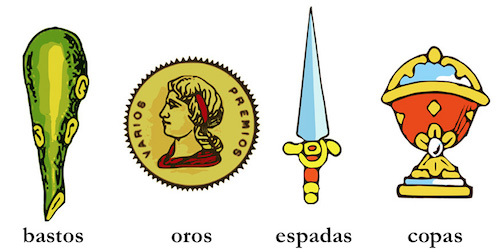The type of deck makes no difference...

A Spanish deck of cards is made of 48 cards and four p a l o s (12 cards each): o r o s , b a s t o s , c o p a s and e s p a d a s .
Antonio, Benito, Carlos, and Diego take turns in the given order drawing a card at random from the deck, returning it and reshuffling. The first to draw o r o s wins. As you may already suspect, the chances of winning are not even. The sooner you start drawing, the better your chances. Their probabilities can be expressed as p A = 1 7 5 a , p B = 1 7 5 b , p C = 1 7 5 c , p D = 1 7 5 d , where a , b , c , d are all distinct integers and only one of them is an odd number. Find its value.
The answer is 27.
This section requires Javascript.
You are seeing this because something didn't load right. We suggest you, (a) try
refreshing the page, (b) enabling javascript if it is disabled on your browser and,
finally, (c)
loading the
non-javascript version of this page
. We're sorry about the hassle.
3 solutions
I had to surrender. I did calculate until the fifth iteration but the numbers were getting out of control very quickly (many figures each) and I couldn't find any way of having 175 in the denominator.
Table [ 4 1 ( 4 3 ) p ∑ i = 0 ∞ ( 4 3 ) 4 i , { p , 0 , 3 } ] ⟹ { 1 7 5 6 4 , 1 7 5 4 8 , 1 7 5 3 6 , 1 7 5 2 7 }
The probability a person will be able to draw in this round of four draws: Table [ ( 4 3 ) p , { p , 0 , 3 } ] ⟹ { 1 , 4 3 , 1 6 9 , 6 4 2 7 } .
The probability of winning if you get to draw in this round of draws: 4 1 .
The probability of winning in this round of draws: 4 1 { 1 , 4 3 , 1 6 9 , 6 4 2 7 } ⟹ { 4 1 , 1 6 3 , 6 4 9 , 2 5 6 2 7 } .
Lastly, we need the infinite sum of the factors of surviving an infinite series of rounds: ∑ i = 0 ∞ ( 4 3 ) 4 i = ∑ i = 0 ∞ ( 2 5 6 8 1 ) i ⟹ 1 7 5 2 5 6 .
Finally, 1 7 5 2 5 6 { 4 1 , 1 6 3 , 6 4 9 , 2 5 6 2 7 } ⟹ { 1 7 5 6 4 , 1 7 5 4 8 , 1 7 5 3 6 , 1 7 5 2 7 }
The key observation is that p B = 4 3 p A , p C = 4 3 p B and p D = 4 3 p C .
Using this and the fact that p A + p B + p C + p D = 1 , we have
p A ( 1 + 4 3 + ( 4 3 ) 2 + ( 4 3 ) 3 ) = 1
Solving gives p A = 1 7 5 6 4 ; we then get p B = 1 7 5 4 8 , p C = 1 7 5 3 6 and p D = 1 7 5 2 7 . The only odd numerator is 2 7 .
Nice solution!
The probability of drawing o r o s is 4 1 , and not drawing o r o s is of course 4 3 .
Antonio goes first. He may win in the 1st turn, or in the 5th provided the rest of the players lose in their respective turns, or in the 9th... p A = 4 1 + ( 4 3 ) 4 × 4 1 + ( 4 3 ) 8 × 4 1 + … = 4 1 × 1 − ( 4 3 ) 4 1 = 1 7 5 6 4
For Benito to win, Antonio must lose his respective turns. Benito's turns are the 2nd, the 6th, the 10th... : p B = 4 3 × 4 1 + ( 4 3 ) 5 × 4 1 + ( 4 3 ) 9 × 4 1 + … = 4 3 × 4 1 × 1 − ( 4 3 ) 4 1 = 1 7 5 4 8 Note that p B = 4 3 p A
The pattern repeats for Carlos, p C = ( 4 3 ) 2 p A = 1 7 5 3 6 and Diego, p D = ( 4 3 ) 3 p A = 1 7 5 27 .
Therefore a = 6 4 , b = 4 8 , c = 3 6 and d = 2 7 .